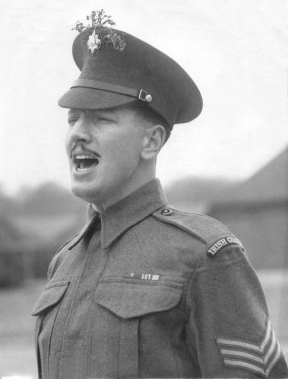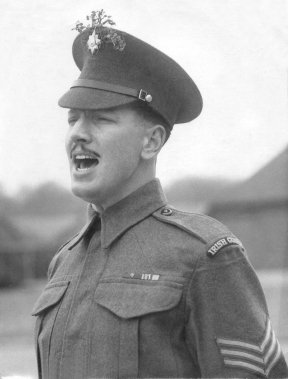In summer 1920, an 18-year-old English woman, Gertrude Nowell Robinson, had a one night stand with a wealthy Jewish textile manufacturer, Neville Blond. In March 1921, after being sent to live with relatives in order to conceal her socially unacceptable pregnancy, she gave birth to a boy – Leslie Jackson. Leslie’s initial identity switch will not be his last.
On his 18th birthday, after attending King Edward’s Grammar School in Birmingham, he enlisted in the Honourable Artillery Company. At the beginning of WWII, he was mobilized and posted to an anti-aircraft battery in London. The HAC was among the most prestigious and one of the world’s oldest military organizations. Alas, Jackson was not impressed.
After overstaying a leave, he was put in detention where he got a chance to meet the Irish Guards for the first time. The Irish Guards is one of the regiments of the British Army that recruits in Northern Ireland and Irish neighborhoods of major cities in Britain.
This was a life-changing experience for young Leslie. He was so impressed by their rigor that he demanded to be transferred to their regiment. Having no Irish blood proved an insurmountable obstacle and he was subsequently declined.
Early in 1941, he met a group of travelling Irish laborers and devised a plan. He deserted the Army and followed them to Glasgow where he acquired papers of one of the workers who decided to leave the UK; Leslie Jackson became John Keneally. Soon, he joined the Irish Guards.
In 1943, his 1st Battalion of the Irish Guards was part of the final assault on Tunis, Tunisia’s capital. The Allied Forces were advancing rapidly and the Irish Guards were tasked with securing a ridge near Medjez el Bab against German counter-attacks. His regiment counted some 200 men.
On 28 April, Keneally spotted a group of 100 Panzer Grenadiers preparing to attack their position. They were at a safe distance, but disorganized and unprepared to defend there position should something, or someone, come their way. Keneally charged down the ridge, alone, firing his Bren light machine gun from the hip. His stunt proved payed off and the enemy fled the scene.
Two days later, he repeated the same scenario, this time, assisted by another comrade. The Nazis suffered great casualties and broke up in disorder. Returning back to his post on the ridge, Keneally was shot in the leg, but he nevertheless continued fighting throughout the day. Out of some 200 members of the Irish Guards, some 90 percent were killed. But the ridge remained secure.

In August 1941, John Keneally was the first Irish Guard member to be awarded the Victoria Cross in WWII. His citation states that he had ‘influenced the whole course of the battle’. He was even mentioned by Winston Churchill, in his famous 1945 speech, ‘Five years of War’. No one could have guessed his real identity.
In 2000, months before he passed away, Keneally published an autobiography, where he confessed his true identity and wrote extensively about his family background and later life. The Honour and the Shame was another risk he took – his medals could have been taken away. Instead, Keneally lived and died a hero.
